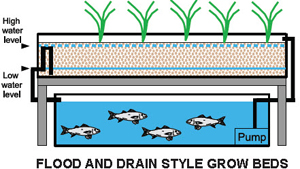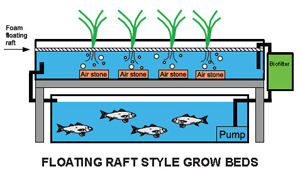Aquaponics
Aquaponics is a combination of aquaculture and hydroponics. You can produce fish and plants in the one system.
How it works
An aquaponics system has three parts - a fish tank, grow beds and a small pump that moves water between the two.
Water from the fish tank, rich with nutrients from fish waste, is pumped into the grow beds.
The plants extract the nutrients, cleaning the water before it is returned to the fish tank.
The two most common styles of grow bed are flood-and-drain and floating raft.


Flood-and-drain grow beds
In this design, the grow bed has clay balls or another medium which holds the plants.
Water is pumped from the fish tank up to the grow beds, flows through the bed and drains by gravity back to the fish tank.
The water level in the grow bed is controlled by a syphon system that cycles a flooding and draining sequence.
Floating raft grow beds
In this design, the grow bed tank is filled with water. The plants grow on floating polystyrene blocks.
Water is pumped from the fish tank up to the grow bed. A special type of filter, called a bio-filter, converts ammonia to nitrates which are taken up by the plants.
An air pump is used to aerate the roots of the plants.
Benefits
The main benefits of an aquaponics system are water savings and the ability to grow fish and plants in the one system.
You can produce a lot of food using only 10% of the water needed to grow plants in the ground.
What to grow
Plants which grow well in an aquaponics system include many Asian vegetables, tomatoes, basil, cucumber, some lettuce types, herbs, melons, eggplants and chillies.
Fish to use
Sleepy cod and barramundi are fish which can be used in a Northern Territory aquaponics system.
During the cooler months a small water heater may be required for barramundi.
Only buy fish from a licensed retail outlet and keep your receipt.
For more information call the Darwin Aquaculture Centre on (08) 8924 4260.
Give feedback about this page.
Share this page:
URL copied!